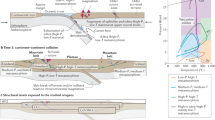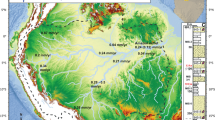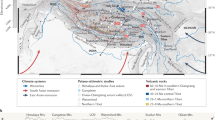Abstract
ONE of the fundamental principles of geology—‘Stille's legacy’1—is the concept that there is a wide contemporaneity of geological events, both tectonic and sedimentary. The concept received notable attention 25 yr ago and raised a scientific controversy2. It is now of interest again because of the present tendency to assume as a causal mechanism of mountain building the relative motions between plates. On the basis of geological evidence it has been shown3 that the diastrophic events of the western Mediterranean do not occur at the same time in the different mountain chains, because collisions between plates are diachronous. Detailed stratigraphical analysis of the units within the Maghrebian Chain4 (from Gibraltar to Calabrian Arc) indicates that, in addition, the initiation of geological events varies from place to place in the same orogen5.
This is a preview of subscription content, access via your institution
Access options
Subscribe to this journal
Receive 51 print issues and online access
$199.00 per year
only $3.90 per issue
Buy this article
- Purchase on Springer Link
- Instant access to full article PDF
Prices may be subject to local taxes which are calculated during checkout
Similar content being viewed by others
References
Stille, H., Grundfragen der vergleichenden Tektonik (Borntraeger, Berlin, 1924); Stille, H., Bull. Am. Ass. Petrol. Geol., 20, (7), 849–880 (1936).
Gilluly, J., Bull. geol. Soc. Am., 60, 561–590 (1949); Gilluly, J., and Stille, H., Geol. Rdsch., 38 (2), 89–111 (1950).
Alvarez, W., Cocozza, T., and Wezel, F. C., Nature, 248, 309–314 (1974).
Durand-Delga, M., Publs Serv. géol Algér. Bull., 39, 89–131 (1969).
Wezel, F. C., Riv. Minr. Siciliana, 219–232, 153–168 (1973); Wezel, F. C., in Geology of Italy (Petroleum Exploration Society, Libya, Tripoli, 1974).
Ryan, W. B. F., et al., Init. Rep. Deep Sea Drilling Project, 13 (1–2) (US Government Printing Office, Washington, DC, 1973).
Wezel, F. C., Nature, 228, 275–276 (1970); Dewey, J. F., Pitman, W. C. III, Ryan, W. B. F., and Bonnin, J., Bull. geol. Soc. Am., 84 (10), 3137–3180 (1973).
Ogniben, L., Geol. Rom., 3, 125–169 (1964); Wezel, F. C., and Guerrera, F., Boll. Soc. geol. Ital., 92, 193–211 (1973).
Dickinson, W. R., Science, 174, 107–113 (1971).
Gélard, J.-P., Lorenz, C., and Magné, J., C.r. Somm. Soc. géol. Fr., 1, 7–9 (1973).
Van Bemmelen, R. W., Proc. K. ned. Akad. Wet. Amsterdam, 36, 740–749 (1933); Van Bemmelen, R. W., Geodynamic models (Elsevier, Amsterdam, 1972).
Opdyke, N. D., Ninkovich, D., Lowrie, W., and Hays, J. D., Earth planet. Sci. Lett., 14, 145–159 (1972).
Maley, T. S., and Johnson, G. L., Deep Sea Res., 18, 109–122 (1971).
Author information
Authors and Affiliations
Rights and permissions
About this article
Cite this article
WEZEL, F. Diachronism of depositional and diastrophic events. Nature 253, 255–257 (1975). https://doi.org/10.1038/253255a0
Received:
Issue Date:
DOI: https://doi.org/10.1038/253255a0
This article is cited by
Comments
By submitting a comment you agree to abide by our Terms and Community Guidelines. If you find something abusive or that does not comply with our terms or guidelines please flag it as inappropriate.



